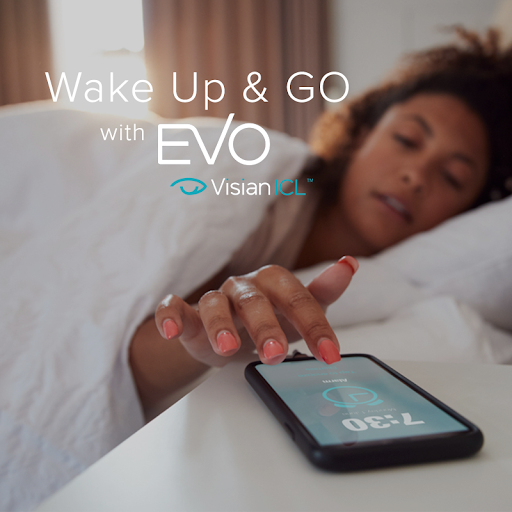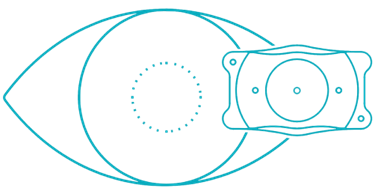Introducing EVO-ICL
EVO-ICL Procedure
Since 1989 The Eye Center has been on the forefront of vision correction procedures. Dr. Boutros and The Eye Center are two names that have come to define a standard of excellence in vision correction. Dr. Boutros has spent the last 30+ years refining the vision correction process. The Eye Center now offers the next generation in advanced vision correction with the EVO Visian ICL (Implantable Collamer® Lens). Call 1-888-844-2020 to schedule your free consultation.
What is EVO ICL lens?
The Implantable Collamer Lens (ICL) for nearsightedness and astigmatism is a refractive lens also known as a phakic IOL. “Phakic” meaning that the natural lens of the eye is in place, and “IOL” meaning intraocular lens, or a lens inside the eye. The EVO ICL is a posterior chamber implant that is introduced through a small incision in the eye and is placed behind the iris (the colored part of the eye), and in front of the natural crystalline lens in order to improve your nearsightedness and astigmatism.
Benefits of EVO ICL
EVO Visian Implantable Collamer Lens (ICL) offers many benefits for patients who are candidates for the ICL procedure and are seeking a vision solution that allows them the freedom of less dependence on glasses or contact lenses. The advantages of EVO Visian ICL include:
- Provides clear, sharp vision[1],[2]
- 20 to 30-minute procedure
- Quick recovery time
- Removable by your doctor
- Offers UV protection
- Not visible once in place
- Can treat nearsightedness with or without astigmatism
- For patients who may not be candidates for LASIK or other vision correction procedures due to thin corneas[3],[4]
- Does not cause dry eye syndrome[5]
- Excellent vision both day and night[1],[2]
- There have been over 2 million implantable collamer lens procedures performed worldwide
- 99.4% of patients surveyed would have the EVO Lens procedure again[3]
- [1] Sanders D, Vukich J. Comparison of implantable collamer lens (ICL) and laser-assisted in situ keratomileusis (LASIK) for Low Myopia. Cornea. 2006
- [2] Igarashi A, Kamiya K, Shimizu K, Komatsu M. Visual Performance after implantable Collamer lens implantation and wavefront-guided laser in situ keratomileusis for high myopia. Am J Opthalmol. 2009
- [3] Parkhurst G, Psolka M, Kezirian G. Phakic intraocular lens implantation in United States military warfighters: A retrospective analysis of early clinical outcomes of the Visian ICL. J Refract Surg. 2011;27(7):473-481
- [4] Gimbel H, et al. Management of myopic astigmatism with phakic intraocular lens implantation. Journal of Cataract & Refractive Surgery, Volume 28, Issue 5, 883 – 886.
- [5] Ganesh S, Brar S, Pawar A. Matched population comparison of visual outcomes and patient satisfaction between 3 modalities for the correction of low to moderate myopic astigmatism. Clin Ophthalmol. 2017 Jul 3;11:1253-1263.
The Procedure
– What to Expect
EVO Implantable Collamer Lens (ICL) is made of biocompatible Collamer material that works in harmony with your eye. Your eye doctor will create a small opening in your cornea that will be used to insert and position the EVO ICL. For most patients, the procedure is virtually painless with numbing drops and it typically takes less than 20 – 30 minutes. Patients typically experience improved vision right away and a quick recovery time.
Is EVO ICL Right for Me?
EVO Visian Implantable Collamer Lens (ICL) is well-suited for a wide variety of people. Ideal candidates for EVO ICL are aged 21 to 45 with nearsightedness with or without astigmatism and have maintained a stable prescription for at least one year. If you are seeking a solution to decrease or eliminate the cost and frustration of traditional contacts or glasses, EVO ICL may be your answer. Contact us to discuss if EVO ICL is right for you.


FAQs
Can the EVO Visian ICL Lens be Removed?
Yes; the EVO Visian ICL is intended to provide permanent vision correction, but it can be removed or upgraded by your surgeon.
Will I be able to feel the EVO Visian ICL Lens?
No, patients should not feel the lens as it does not adhere to any structures within the eye and does not move once in place.
Will other people be able to see the EVO Visian ICL Lens?
No, the Visian EVO lens is placed behind your iris where only your eye doctor will be able to detect it.
Are there any risks with the EVO Visian ICL Procedure?
Any medical procedure has certain risks associated with it. Potential complications of the EVO ICL procedure, although rare, include inflammation, an increase in eye pressure, or the need for an additional procedure, like an ICL exchange. While these potential risks are mitigated as much as possible, they can all typically be addressed early and without long-term side effects.



Important Safety Information for EVO ICL
The EVO ICL lens is intended to correct/reduce nearsightedness between -3.0 D up to -20.0 D and treat astigmatism from 1.0 D to 4.0 D. If you have nearsightedness within these ranges, EVO ICL surgery may improve your distance vision without eyeglasses or contact lenses. Because the EVO ICL corrects for distance vision, it does not eliminate the need for reading glasses, you may require them at some point, even if you have never worn them before. Since implantation of the EVO ICL is a surgical procedure, before considering EVO ICL surgery you should have a complete eye examination and talk with your eye care professional about EVO ICL surgery, especially the potential benefits, risks, and complications. You should discuss the time needed for healing after surgery. Complications, although rare, may include need for additional surgical procedures, inflammation, loss of cells from the back surface of the cornea, increase in eye pressure, and cataracts. You should NOT have EVO ICL surgery if your doctor determines that 1) the shape of your eye is not appropriate, 2) you do not meet the minimum endothelial cell density for your age at the time of implantation, 3) you have moderate to severe glaucoma, 4) your vision is not stable; or 5) if you are pregnant or nursing. For additional information with potential benefits, risks and complications please visit DiscoverICL.com
- Sanders D, Vukich J. Comparison of implantable collamer lens (ICL) and laser-assisted in situ keratomileusis (LASIK) for Low Myopia. Cornea. 2006
- Igarashi A, Kamiya K, Shimizu K, Komatsu M. Visual Performance after implantable Collamer lens implantation and wavefront-guided laser in situ keratomileusis for high myopia. Am J Opthalmol. 2009
- Parkhurst G, Psolka M, Kezirian G. Phakic intraocular lens implantation in United States military warfighters: A retrospective analysis of early clinical outcomes of the Visian ICL. J Refract Surg. 2011;27(7):473-481
- Gimbel H, et al. Management of myopic astigmatism with phakic intraocular lens implantation. Journal of Cataract & Refractive Surgery, Volume 28, Issue 5, 883 – 886.
- Ganesh S, Brar S, Pawar A. Matched population comparison of visual outcomes and patient satisfaction between 3 modalities for the correction of low to moderate myopic astigmatism. Clin Ophthalmol. 2017 Jul 3;11:1253-1263.
- Parkhurst GD. A prospective comparison of phakic collamer lenses and wavefront-optimized laser-assisted in situ keratomileusis for correction of myopia. Clin Ophthalmol. 2016 Jun 29;10:1209-15.m J Ophthalmol 2021;226: 117–125
- Ganesh S, Brar S, Pawar A. Matched population comparison of visual outcomes and patient satisfaction between 3 modalities for the correction of low to moderate myopic astigmatism. Clinical Ophthalmology 2017: 11: 1253–1263.
- Packer M. The Implantable Collamer Lens with a central port: review of the literature. Clinical Ophthalmology 2018: 12: 2427–2438.



